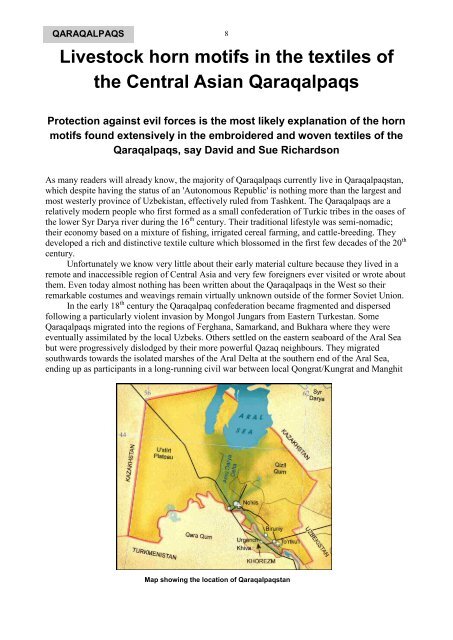QARAQALPAQS8Livestock horn motifs in the textiles ofthe Central <strong>Asian</strong> QaraqalpaqsProtection against evil forces is the most likely explanation of the hornmotifs found extensively in the embroidered and woven textiles of theQaraqalpaqs, say David and Sue RichardsonAs many readers will already know, the majority of Qaraqalpaqs currently live in Qaraqalpaqstan,which despite having the status of an 'Autonomous Republic' is nothing more than the largest andmost westerly province of Uzbekistan, effectively ruled from Tashkent. The Qaraqalpaqs are arelatively modern people who first formed as a small confederation of Turkic tribes in the oases ofthe lower Syr Darya river during the 16 th century. Their traditional lifestyle was semi-nomadic;their economy based on a mixture of fishing, irrigated cereal farming, and cattle-breeding. Theydeveloped a rich and distinctive textile culture which blossomed in the first few decades of the 20 thcentury.Unfortunately we know very little about their early material culture because they lived in aremote and inaccessible region of Central Asia and very few foreigners ever visited or wrote aboutthem. Even today almost nothing has been written about the Qaraqalpaqs in the West so theirremarkable costumes and weavings remain virtually unknown outside of the former Soviet Union.In the early 18 th century the Qaraqalpaq confederation became fragmented and dispersedfollowing a particularly violent invasion by Mongol Jungars from Eastern Turkestan. SomeQaraqalpaqs migrated into the regions of Ferghana, Samarkand, and Bukhara where they wereeventually assimilated by the local Uzbeks. Others settled on the eastern seaboard of the Aral Seabut were progressively dislodged by their more powerful Qazaq neighbours. They migratedsouthwards towards the isolated marshes of the Aral Delta at the southern end of the Aral Sea,ending up as participants in a long-running civil war between local Qongrat/Kungrat and ManghitMap showing the location of Qaraqalpaqstan
9 QARAQALPAQSA decoratedQaraqalpaq yurtin a farmyard atMu'yten awıl(hamlet) in thenorthern AralDeltaUzbeks.Although many Qaraqalpaqs initially allied themselves with the rebel Manghits in the AralDelta, the ruling Qongrats of Khiva pursued a strategy of divide and rule. As an increasing numberof Qaraqalpaq tribes were attracted over to the Khivan side by the lure of land grants, the rebelfactions were increasingly isolated. By the early nineteenth century the entire Qaraqalpaq nationhad been subjugated by Khiva and resettled within the Aral Delta.Throughout their short and tumultuous history the Qaraqalpaqs experienced a life that wasfull of hardship and danger. In the winter there was the ever-present threat of Turkmen attack – thefrozen waterways of the Aral Delta providing easy access for raiding parties intent on stealingtheir cattle and kidnapping their wives and daughters. In response many Qaraqalpaqs relocatedtheir yurts to communal qala refuges, defended by high mud-brick walls. In the spring andsummer the capricious Amu Darya could flood the lower delta channels without warning, forcingfamilies to suddenly relocate their yurts and livestock to higher ground. Their spring crops werevulnerable to drought, blight, and plagues of locusts, while their animals were exposed torespiratory ailments, the bites of mosquitoes and gadflies, and attack by the Aral tugay tiger. Birthand infant mortality was high and diseases like scabies, scurvy, trachoma, and syphilis werecommon.The Qaraqalpaqs coped with these vicissitudes with the help of a complex system ofsupernatural beliefs, overlain by a thin veneer of Sunni Islam. Many of these beliefs have ancientorigins, going back to the time of the early Turks and perhaps even earlier. Of course theQaraqalpaqs never documented their cults and rituals so, as modern outsiders, we can never fullycomprehend their world view. We are left with a superficial understanding gleaned from elderlyQaraqalpaqs who were questioned by various Soviet ethnographers in the decades that followedthe Second World War. One of the more comprehensive studies was conducted in the 1970s by thelocal ethnographer Xojamet Esbergenov, by which time people's traditional beliefs had beeneroded by half a century of Communist rule.The Qaraqalpaqs had no consistent theological system of spiritual belief. They believed in aplethora of holy saints, or pirs, and evil spirits known variously as jins, shaytans, or albaslı, alongwith a multitude of notions and superstitions affecting every aspect of their lives. These includednot only the important phases of birth, marriage, and death, but even everyday tasks like thetreatment of a sick calf, the tilling and irrigation of crops, the weaving of a yurt band, or theerection of a yurt. Each event required the performance of various traditional rites, and rituals. Insome cases assistance had to be sought from one of the various holy saints who patronized a
















